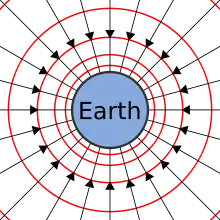Gravitational energy
Gravitational energy or gravitational potential energy is the potential energy a massive object has in relation to another massive object due to gravity. It is the potential energy associated with the gravitational field, which is released (converted into kinetic energy) when the objects fall towards each other. Gravitational potential energy increases when two objects are brought further apart.

For two pairwise interacting point particles, the gravitational potential energy is given by
where and are the masses of the two particles, is the distance between them, and is the gravitational constant.[1]
Close to the Earth's surface, the gravitational field is approximately constant, and the gravitational potential energy of an object reduces to
where is the object's mass, is the gravity of Earth, and is the height of the object's center of mass above a chosen reference level.[1]
Newtonian mechanics
In classical mechanics, two or more masses always have a gravitational potential. Conservation of energy requires that this gravitational field energy is always negative, so that it is zero when the objects are infinitely far apart.[2] The gravitational potential energy is the potential energy an object has because it is within a gravitational field.
The force between a point mass, , and another point mass, , is given by Newton's law of gravitation:[3]
To get the total work done by an external force to bring point mass from infinity to the final distance (for example the radius of Earth) of the two mass points, the force is integrated with respect to displacement:
Because , the total work done on the object can be written as:[4]
General relativity

In general relativity gravitational energy is extremely complex, and there is no single agreed upon definition of the concept. It is sometimes modelled via the Landau–Lifshitz pseudotensor[5] that allows retention for the energy-momentum conservation laws of classical mechanics. Addition of the matter stress–energy-momentum tensor to the Landau–Lifshitz pseudotensor results in a combined matter plus gravitational energy pseudotensor that has a vanishing 4-divergence in all frames—ensuring the conservation law. Some people object to this derivation on the grounds that pseudotensors are inappropriate in general relativity, but the divergence of the combined matter plus gravitational energy pseudotensor is a tensor.
See also
References
- "Gravitational Potential Energy". hyperphysics.phy-astr.gsu.edu. Retrieved 10 January 2017.
- For a demonstration of the negativity of gravitational energy, see Alan Guth, The Inflationary Universe: The Quest for a New Theory of Cosmic Origins (Random House, 1997), ISBN 0-224-04448-6, Appendix A—Gravitational Energy.
- MacDougal, Douglas W. (2012). Newton's Gravity: An Introductory Guide to the Mechanics of the Universe (illustrated ed.). Springer Science & Business Media. p. 10. ISBN 978-1-4614-5444-1. Extract of page 10
- Tsokos, K. A. (2010). Physics for the IB Diploma Full Colour (revised ed.). Cambridge University Press. p. 143. ISBN 978-0-521-13821-5. Extract of page 143
- Lev Davidovich Landau & Evgeny Mikhailovich Lifshitz, The Classical Theory of Fields, (1951), Pergamon Press, ISBN 7-5062-4256-7